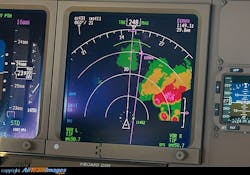Marine Corps chooses 3D weather radar avionics from Honeywell for upgrade of KC-130T aircraft
Honeywell Aerospace has been selected by the U.S. Navy to provide Honeywell's IntuVue 3-D weather radar system as part of its upgrade for 14 U.S. Marine Corps KC-130T aircraft.
The IntuVue RDR-4000M incorporates skin-paint mode during formation and air refueling operations. Skin-paint mode enables a pilot to detect another aircraft and either home in on it or navigate toward it, without requiring visual contact, or maintain aircraft separation during conditions of reduced visibility.
"By using the IntuVue RDR-4000M on its KC-130Ts, the U.S. Marine Corps will be better prepared to handle severe weather, hail, lightning and turbulence," says Heath Patrick, vice president for Americas defense aftermarkets at Honeywell Aerospace.
A feature of the RDR-4000M radar is its use of a three-dimensional volumetric buffer to store a 3-D map of the weather and terrain visible by the radar. This technology enables the system to process and present the pilot with relevant information to simplify operations and decision making.
The RDR-4000M weather radar helps reduce pilot workload by automatically interpreting and displaying weather returns as relevant or non-relevant.
Related: Pocket-sized USB interfaces to ARINC 708 weather radar avionics introduced by Ballard
Honeywell's IntuVue RDR-4000M provides three-dimensional, automatic scanning for weather from wingtip to wingtip and from the ground up to 60,000 feet. Key features include weather detection meeting or exceeding the requirements in DO-173 and TSO-C63c; predictive hail and lightning capability; and turbulence warning out to 60 nautical miles.
Combined, these features provide pilots with a weather radar that enables efficient and safe flight routing, which saves fuel and enhances crew safety.
For more information contact Honeywell Aerospace online at http://aerospace.honeywell.com.

